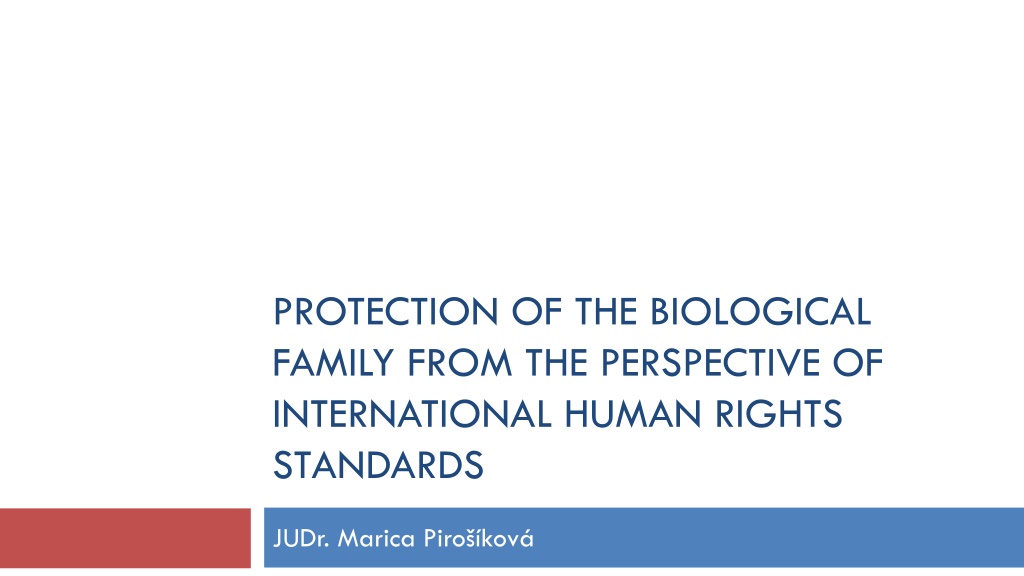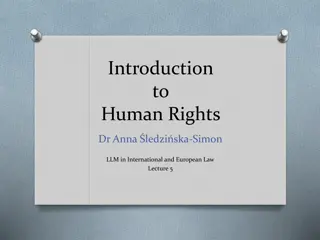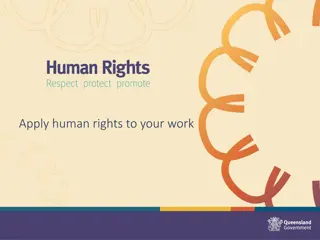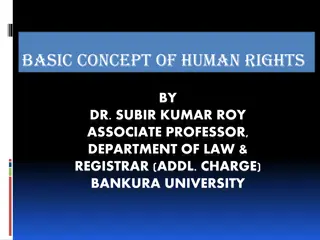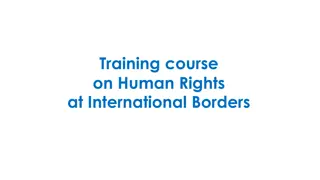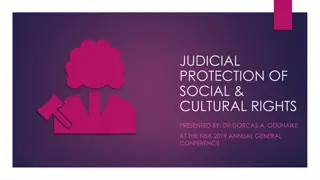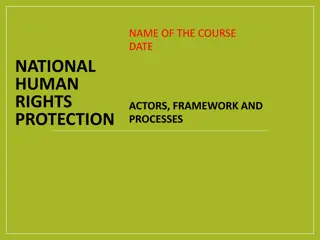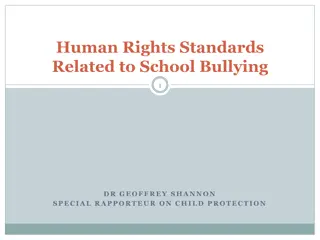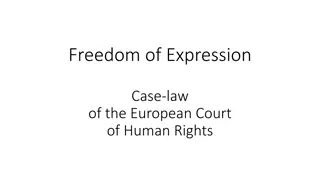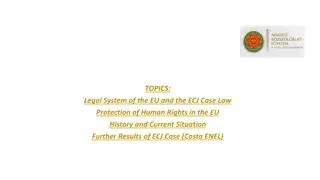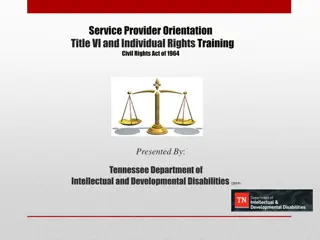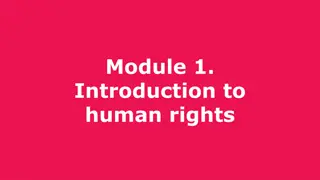Protection of the Biological Family: International Human Rights Perspective
European Court of Human Rights emphasizes the protection of the biological family as a fundamental right. Cases highlight violations of family rights due to financial reasons and failure to consider the best interests of the child. Authorities are urged to provide support and guidance to families in vulnerable situations to maintain family ties and avoid unnecessary separation.
Download Presentation

Please find below an Image/Link to download the presentation.
The content on the website is provided AS IS for your information and personal use only. It may not be sold, licensed, or shared on other websites without obtaining consent from the author. Download presentation by click this link. If you encounter any issues during the download, it is possible that the publisher has removed the file from their server.
E N D
Presentation Transcript
PROTECTION OF THE BIOLOGICAL FAMILY FROM THE PERSPECTIVE OF INTERNATIONAL HUMAN RIGHTS STANDARDS JUDr. Marica Piro kov
Case law of the European Court of Human Rights In the case law of the European Court of Human Rights ( the Court ) it is absolutely clear that it primarily protects a biological family. According to the Court, any separation of the family constitutes a serious interference with the right to a family life and must therefore be based on sufficiently serious and compelling arguments motivated by the interests of the child (see Scozzari and Giunta v. Italy, Grand Chamber judgment, 13 July 2000, 148). The Court did not consider the poor social situation (e.g. judgment Walla and Wallov v. the Czech Republic, 26 October 2006) or the lack of intellect (e.g. judgment Kutzner v. Germany, 26 February 2002) as relevant grounds for the removal of the child. The Court stressed that the role of the welfare authorities is to help people with problems and to advise them on various options to overcome their difficulties. In the case of vulnerable individuals, authorities are obliged to provide special care and increased protection.
Case law of the European Court of Human Rights The case R. M. S. v. Spain (judgment, 18 June 2013) concerned the placement of a child in foster care because of the financial situation of the mother, without taking into account the subsequent change in the circumstances. In particular, the applicant complained that she had been deprived of any contact with her daughter and was separated from her for no good reason. The Court found that there was a violation of Article 8 of the Convention, concluding that the authorities had not made reasonable and effective efforts to guarantee the applicant the right to live with her daughter. In the case of Zhou v. Italy (judgment, 21 January 2014), the Court concluded that there was a violation of Article 8 of the Convention, finding that the Italian authorities had failed to fulfil their obligations prior to the decision to break family ties and did not make adequate and sufficient provision for the applicant to live with her child. In particular, the overriding need to maintain family ties between the applicant in a vulnerable situation and her son was not duly taken into account. The judicial authorities have only identified difficulties which could have been overcome by targeted assistance from social welfare authorities. The applicant had no opportunity to re-establish the relationship with her son; in fact, the experts did not assess the real possibilities of improving the applicant s ability to care for her son, taking into account her medical condition. In addition, the Italian Government has not provided a convincing explanation that could justify the breach of the maternal bond between the applicant and her son.
Case law of the European Court of Human Rights These principles have been repeatedly confirmed and summarized in a recent judgment of the Grand Chamber of the Court in Strand Lobben and Others v Norway (Grand Chamber judgment, 10 September 2019) General principles: The first paragraph of Article 8 of the Convention guarantees to everyone the right to respect for his or her family life. As is well established in the Court s case-law, the mutual enjoyment by parent and child of each other s company constitutes a fundamental element of family life, and domestic measures hindering such enjoyment amount to an interference with the right protected by this provision. Any such interference constitutes a violation of this Article unless it is in accordance with the law , pursues an aim or aims that is or are legitimate under its second paragraph and can be regarded as necessary in a democratic society (see, among other authorities, K. and T. v. Finland [GC], no. 25702/94, 151, ECHR 2001-VII; and Johansen, cited above, 52). In determining whether the latter condition was fulfilled, the Court will consider whether, in the light of the case as a whole, the reasons adduced to justify that measure were relevant and sufficient for the purposes of paragraph 2 of Article 8 (see, among many other authorities, Paradiso and Campanelli, 179). The notion of necessity further implies that the interference corresponds to a pressing social need and, in particular, that it is proportionate to the legitimate aim pursued, regard being had to the fair balance which has to be struck between the relevant competing interests (ibid., 181).
Case law of the European Court of Human Rights In so far as the family life of a child is concerned, the Court reiterates that there is a broad consensus, including in international law, in support of the idea that in all decisions concerning children, their best interests are of paramount importance (see, among other authorities, Neulinger and Shuruk v. Switzerland [GC], no. 41615/07, 135, ECHR 2010). Indeed, the Court has emphasised that in cases involving the care of children and contact restrictions, the child s interests must come before all other considerations (see Jovanovic, cited above, 77, and Gnahor v. France, no. 40031/98, 59, ECHR 2000-IX). At the same time, it should be noted that regard for family unity and for family reunification in the event of separation are inherent considerations in the right to respect for family life under Article 8. Accordingly, in the case of imposition of public care restricting family life, a positive duty lies on the authorities to take measures to facilitate family reunification as soon as reasonably feasible (K. and T. v. Finland, cited above, 178).
Case law of the European Court of Human Rights In instances where the respective interests of a child and those of the parents come into conflict, Article 8 requires that the domestic authorities should strike a fair balance between those interests and that, in the balancing process, particular importance should be attached to the best interests of the child which, depending on their nature and seriousness, may override those of the parents (see, for instance, Sommerfeld v. Germany [GC], no. 31871/96, 64, ECHR 2003-VIII (extracts)), and the references therein). Generally, the best interests of the child dictate, on the one hand, that the child s ties with its family must be maintained, except in cases where the family has proved particularly unfit, since severing those ties means cutting a child off from its roots. It follows that family ties may only be severed in very exceptional circumstances and that everything must be done to preserve personal relations and, if and when appropriate, to rebuild the family (see Gnahor , cited above, 59). On the other hand, it is clearly also in the child s interest to ensure its development in a sound environment, and a parent cannot be entitled under Article 8 to have such measures taken as would harm the child s health and development (see, among many other authorities, Neulinger and Shuruk, cited above, 136; Elsholz v. Germany [GC], no. 25735/94, 50, ECHR 2000-VIII; and Mar lek v. the Czech Republic, no. 8153/04, 71, 4 April 2006). An important international consensus exists to the effect that a child shall not be separated from his or her parents against their will, except when competent authorities subject to judicial review determine, in accordance with applicable law and procedures, that such separation is necessary for the best interests of the child (see Article 9 1 of the United Nations Convention on the Rights of the Child, recited in paragraph 134 above). In addition, it is incumbent on the Contracting States to put in place practical and effective procedural safeguards for the protection of the best interests of the child and to ensure their implementation (see the United Nations Committee on the Rights of the Child General Comment No. 14 (2013) on the right of the child to have his or her best interests taken as a primary consideration, paragraphs 85 and 87, quoted at paragraph 136 above).
Case law of the European Court of Human Rights Another guiding principle is that a care order should be regarded as a temporary measure, to be discontinued as soon as circumstances permit, and that any measures implementing temporary care should be consistent with the ultimate aim of reuniting the natural parents and the child (see, for instance, Olsson v. Sweden (no. 1), 24 March 1988, 81, Series A no. 130). The above-mentioned positive duty to take measures to facilitate family reunification as soon as reasonably feasible will begin to weigh on the competent authorities with progressively increasing force as from the commencement of the period of care, subject always to its being balanced against the duty to consider the best interests of the child (see, for example, K. and T. v. Finland, cited above, 178). In this type of case the adequacy of a measure is to be judged by the swiftness of its implementation, as the passage of time can have irremediable consequences for relations between the child and the parent with whom it does not live (see, inter alia, S.H. v. Italy, no. 52557/14, 42, 13 October 2015). Thus, where the authorities are responsible for a situation of family breakdown because they have failed in their above-mentioned obligation, they may not base a decision to authorise adoption on the grounds of the absence of bonds between the parents and the child (see Pontes v. Portugal, no. 19554/09, 92 and 99, 10 April 2012). Furthermore, the ties between members of a family and the prospects of their successful reunification will perforce be weakened if impediments are placed in the way of their having easy and regular access to each other (see Scozzari and Giunta, cited above, 174; and Olsson (No. 1), cited above, 81). However, when a considerable period of time has passed since the child was originally taken into public care, the interest of a child not to have his or her de facto family situation changed again may override the interests of the parents to have their family reunited (see K. and T. v. Finland, cited above, 155).
Case law of the European Court of Human Rights As regards replacing a foster home arrangement with a more far-reaching measure such as deprivation of parental responsibilities and authorisation of adoption, with the consequence that the applicants legal ties with the child are definitively severed, it is to be reiterated that such measures should only be applied in exceptional circumstances and could only be justified if they were motivated by an overriding requirement pertaining to the child s best interests (see, for example, Johansen, cited above, 78, and Aune, cited above, 66). It is in the very nature of adoption that no real prospects for rehabilitation or family reunification exist and that it is instead in the child s best interests that he or she be placed permanently in a new family (see R. and H. v. the United Kingdom, no. 35348/06, 88, 31 May 2011). In determining whether the reasons for the impugned measures were relevant and sufficient for the purpose of paragraph 2 of Article 8 of the Convention, the Court will have regard to the fact that perceptions as to the appropriateness of intervention by public authorities in the care of children vary from one Contracting State to another, depending on such factors as traditions relating to the role of the family and to State intervention in family affairs and the availability of resources for public measures in this particular area. However, consideration of what is in the best interests of the child is in every case of crucial importance. Moreover, it must be borne in mind that the national authorities have the benefit of direct contact with all the persons concerned, often at the very stage when care measures are being envisaged or immediately after their implementation. It follows from these considerations that the Court s task is not to substitute itself for the domestic authorities in the exercise of their responsibilities for the regulation of the care of children and the rights of parents whose children have been taken into public care, but rather to review under the Convention the decisions taken by those authorities in the exercise of their power of appreciation (see, for example, K. and T. v. Finland, cited above, 154; and Johansen, cited above, 64).
Case law of the European Court of Human Rights The margin of appreciation to be accorded to the competent national authorities will vary in the light of the nature of the issues and the seriousness of the interests at stake, such as, on the one hand, the importance of protecting a child in a situation which is assessed as seriously threatening his or her health or development and, on the other hand, the aim to reunite the family as soon as circumstances permit. The Court thus recognises that the authorities enjoy a wide margin of appreciation in assessing the necessity of taking a child into care (see, for example, K. and T. v. Finland, cited above, 155; and Johansen, cited above, 64). However, this margin is not unfettered. For example, the Court has in certain instances attached weight to whether the authorities, before taking a child into public care, had first attempted to take less drastic measures, such as supportive or preventive ones, and whether these had proved unsuccessful (see, for example, Olsson (no. 1), cited above, 72-74; R.M.S. v. Spain, no. 28775/12, 86, 18 June 2013, 86; and Kutzner v. Germany, no. 46544/99, 75, ECHR 2002-I). A stricter scrutiny is called for in respect of any further limitations, such as restrictions placed by the authorities on parental rights of access, and of any legal safeguards designed to secure an effective protection of the right of parents and children to respect for their family life. Such further limitations entail the danger that the family relations between the parents and a young child are effectively curtailed (see K. and T. v. Finland, cited above, ibid., and Johansen, cited above, ibid.).
Case law of the European Court of Human Rights In cases relating to public-care measures, the Court will further have regard to the authorities decision-making process, to determine whether it has been conducted such as to secure that the views and interests of the natural parents are made known to and duly taken into account by the authorities and that they are able to exercise in due time any remedies available to them (see, for instance, W. v. the United Kingdom, 8 July 1987, 63, Series A no. 121, and Elsholz, cited above, 52). What has to be determined is whether, having regard to the particular circumstances of the case and notably the serious nature of the decisions to be taken, the parents have been involved in the decision-making process, seen as a whole, to a degree sufficient to provide them with the requisite protection of their interests and have been able fully to present their case (see, for example, W. v. the United Kingdom, cited above, 64; T.P. and K.M. v. the United Kingdom [GC], no. 28945/95, 72, ECHR 2001-V (extracts); Neulinger and Shuruk, cited above, 139; and Y.C. v. the United Kingdom, no. 4547/10, 138, 13 March 2012). From the foregoing considerations it follows that natural parents exercise of judicial remedies with a view to obtaining family reunification with their child cannot as such be held against them. In addition, in cases of this kind there is always the danger that any procedural delay will result in the de facto determination of the issue submitted to the court before it has held its hearing. Equally, effective respect for family life requires that future relations between parent and child be determined solely in the light of all relevant considerations and not by the mere effluxion of time (see W. v. the United Kingdom., cited above, 65).
Case law of the European Court of Human Rights Whether the decision-making process sufficiently protected a parent s interests depends on the particular circumstances of each case (see, for example, Sommerfeld, cited above, 68). With a view to its examination of the present instance, the Court observes that in the aforementioned case it was called upon to examine the issue of ordering a psychological report on the possibilities of establishing contact between the child and the applicant. It observed that as a general rule it was for the national courts to assess the evidence before them, including the means to ascertain the relevant facts (see Vidal v. Belgium, 22 April 1992, 33, Series A no. 235-B). It would be going too far to say that domestic courts are always required to involve a psychological expert on the issue of awarding contact to a parent not having custody, but this issue depends on the specific circumstances of each case, having due regard to the age and maturity of the child concerned (see Sommerfeld, cited above, 71).
Case law of the European Court of Human Rights The Government of the Slovak Republic as well as the Government of the Czech Republic in their intervention pointed out the necessity to maintain these principles. On the other hand, the defendant State of Norway as well as the intervening governments of Italy, Denmark and the United Kingdom submitted that in such cases the Court should not act as a fourth instance and reassess the circumstances of the case. However, the Court did so and came to the conclusion that there has been a violation of the applicants rights. The Slovak Republic availed itself of the possibility under Article 36 paragraph 2 of the Convention and intervened, apart from the Strand Lobben case, also in the cases of K. O. and V. M. v. Norway and Bodnariu and others v. Norway. On 17 June 2019, another 16 complaints concerning this issue were notified to the Norwegian Government. The Slovak Republic applied for authorisation of interventions in all of the 16 cases. The Slovak Republic also requested for a permission to intervene in another group of cases of a similar nature against Norway which were notified to the Norwegian Government in October of this year. In these interventions, the Slovak Republic will continue to support the Court's current case-law primarily protecting the biological family from which it also did not divert in the Strand Lobben case.
Case law of the European Court of Human Rights In the case of Strand Lobben, the applicants were Mrs T. Strand Lobben and her son X., both Norwegian nationals. X. is the applicants first child, born in 2008. After the difficulties she had during her pregnancy, the applicant contacted the welfare services for help. She accepted their offer to stay in the family centre during the first months of her child's life. However, the following month after the birth of the baby, she decided to leave the centre. The authorities immediately took her child and placed him in foster care because of concerns that he would not be provided with sufficient nutrition to survive. The child remained in foster care for another three years, until the social welfare authorities approved the adoption of the foster parents in December 2011. Regarding the foster care, in 2010 the Norwegian courts ruled that it was not in the best interests of the child to stop the foster care, given his special needs and limited parental abilities of the biological mother. In 2011, a local authority composed of a lawyer, a psychologist and an associate, decided to deprive the mother of her parental rights and allow the adoption of the boy. The body listened to 21 witnesses for a total of three days. The applicant was present and was represented by a lawyer. Finally, it was decided that adoption was in the best interests of the child. The applicant appealed to the Municipal Court and the hearing took place in 2012. She again participated and was again represented by a solicitor. For three days witnesses were heard by a professional judge, a psychologist and a lay judge. In its judgment of February 2012, the Municipal Court found that although the applicant's situation had improved in some areas (she got married and had another child born in 2011), she did not show an improvement in the perception or understanding of her son who was psychologically vulnerable and in need of a quiet, secure and supportive environment.
Case law of the European Court of Human Rights While making its decision, the Court took into account three years of meetings during which the son was not psychologically attached to his biological mother, as well as the safety that his foster parents could provide him with in the upcoming years. Referring to Article 8 (right to respect for a private life) of the Convention, the applicants contested the decision of the national authorities concerning the deprivation of Ms Strand Lobben s parental rights and the release of X for adoption. First by a judgment of the Chamber from 30 November 2017, the Court by a vote of four to three found that Article 8 of the Convention had not been violated. It stated in its judgment that the adoption decision was justified by the exceptional circumstances of the case. In general, national authorities have faced a difficult and extremely sensitive task of balancing conflicting interests in such a difficult case. However, they were motivated by the best interests of the child especially in the light of the special care he required. On 9 April 2018 the panel of five judges of the Grand Chamber of the Court accepted the applicants' request to refer the case to the Grand Chamber. In the proceedings before the Grand Chamber adoptive parents of X, Belgium, Bulgaria, Czech Republic, Denmark, Slovak Republic, Italy and the United Kingdom, as well as the Alliance Defending Freedom International (ADF), the Associazione italiana dei magistrati per i minorenni' per la famiglia (AIMMF) and AIRE Center all intervened in the case.
Case law of the European Court of Human Rights The Government of the Slovak Republic submitted in their observations that the Court s case-law was perfectly clear in that it primarily protected the biological family. Placing a child in foster care was an extreme measure and domestic authorities were required to adopt other measures if such were able to achieve the pursued aim. In particular, where a decision had been explained in terms of a need to protect the child from danger, the existence of such a danger should be actually established. Simultaneously, taking a child into care should be regarded as a temporary measure, to be discontinued as soon as circumstances permitted, and any measure of implementation should be consistent with the ultimate aim of reuniting the natural parent with his or her child. The Government of the Slovak Republic made further comments on a case in which Slovak citizens had been affected by child welfare measures and on international concern about child welfare measures adopted in the respondent State.
Case law of the European Court of Human Rights On 10 September 2019 the Grand Chamber of the Court delivered its judgment in which it decided by thirteen votes to four that Article 8 of the Convention had been infringed in respect of both applicants. In its judgment the Court first recalled its settled case-law on the best interests of the child and the protection of the biological family. Applying the case-law to the present case the Court stated that the process leading to the withdrawal of parental responsibilities and consent to adoption shows that the domestic authorities did not attempt to perform a genuine balancing exercise between the interests of the child and his biological family, but focused on the child s interests instead of trying to combine both sets of interests, and moreover did not seriously contemplate any possibility of the child s reunification with his biological family. In this context, the Court, in particular, is not persuaded that the competent domestic authorities duly considered the potential significance of the fact that at the time when the first applicant applied to have the care order lifted or, in the alternative, to be granted extended contact rights she was going through substantial changes in her life: in the same summer and autumn as the impugned proceedings commenced she married and had a second child. In this regard, as the City Court s decision was largely premised on an assessment of the first applicant s lack of capacity to provide care, the factual basis on which it relied in making that assessment appears to disclose several shortcomings in the decision-making process.
Case law of the European Court of Human Rights The Court further noted that the decisions under consideration had been taken in a context where there had only been very limited contact between the first applicant and X. and regarding the visits, the Court stated that those measures did not specifically lead to the first applicant freely forming a bond with X., for example regarding the venue for meetings and the attendance on them. Although the visits often did not work well and very little was done to try out other alternative measures. Such occasional contact that formed between the applicants since X. was admitted to foster care could only reveal limited evidence of the first applicant s parenting skills. In addition the Court found it very worrying that there were no updated expert reports other than those ordered in previous proceedings between 2009 and 2010 in respect of placing X. in foster care. The absence of a new expert review substantially reduced the factual assessment of the situation of the first applicant and her ability to care for the child at that time. It was also apparent from the reasoning of the referring court that in assessing the first applicant 's ability to care for her child she paid particular attention to the needs of X. due to his vulnerability. While X.'s vulnerability was the main reason for the initial decision to place him in foster care, the court's judgment contained no information on how this vulnerability could continue despite the fact that he had lived in foster care since he was three weeks old. Nor did it contain any analysis of the nature of his vulnerability except that experts briefly described that X. was easily stressed and needed a lot of peace, security and support and that he expressed his resistance and resignation against the contact with the first applicant especially when faced with her emotional outbursts.
Case law of the European Court of Human Rights In the Court's view, given the gravity of the interests at stake, the competent authorities should have assessed the vulnerability of X in the present proceedings in more detail. Taking into account in particular the limited evidence that could have been obtained from the visits carried out also coupled with the fact that despite the new family situation of the first applicant they failed to order a new professional review of her ability to take care of X and due to insufficient justification for X s vulnerability, the Court was of the opinion that the decision-making process that led to the decision on the deprivation of the applicant s parental rights and the release of X for adoption was not carried out to ensure that all views and interests of the parties were duly taken into account. The Norwegian authorities' conduct was not accompanied by the guarantees which were proportionate to the gravity of the interference and the gravity of the interests at stake. Article 8 of the Convention was therefore infringed. The Court awarded the first applicant 25 000 EUR as non-pecuniary damage and also with the reimbursement of trial costs. In relation to the other applicant, the Court stated that the finding of a violation of the Convention was a sufficient satisfaction for him. The judgment is accompanied by partially concurrent opinions of the judges (Ranzoni, Yudkivska, K ris, Harutyunyan, Paczolay and Chanturia), as well as dissenting opinions of the judges (Kj lbro, Pol kov , Koskelo and Nord n).
Case law of the European Court of Human Rights In the case of M. A. K. and R.K. v. the United Kingdom the child had a rare skin disease whose manifestations were confused with the effects of sexual abuse and the parents were restrained from contacting the child for 10 days while the child was in the hospital. According to the Court the right to a family life was infringed on the grounds that the skin disease should have been diagnosed more quickly criticizing the delay of several days between the decision to carry out a diagnostic test for the skin disease and the actual realisation of the tests (judgment, 23 March 2010, 73) . Similarly the Court concluded that in the A. D. and O. D. v. the United Kingdom case (judgment, 16 March 2010, 85-94), there had also been a violation, when a child suffering from a disease causing excessive bone fragility was not promptly returned to parental care and the authorities took disproportionate measures, like putting the child into foster care while the child could have been entrusted to the relatives and instead they relocated the whole family for examinations far from their home.
Case law of the European Court of Human Rights People whose rights have been affected must be able to participate in the proceedings sufficiently to protect their interests (for example children should be heard by the court with respect to their age) - except in urgent situations where action is needed in relation to the immediate threat and information would deprive the State of its effectiveness - these are exceptional situations and the Court examines in detail whether the State has given sufficient reasons to suddenly remove the child from the care of his/her parents. Of course there is also the access to the documents, to the opportunity to comment and to have proceedings without any delay (see for example T. P. and K. M. v. the United Kingdom, Grand Chamber judgment, 10 May 2001). In the case of B.B. and F.B. v. Germany (judgment, 14 March 2013) the parents were deprived of their parental rights in 2008 after their 12-year-old daughter reported that her father had repeatedly and brutally beaten her and her 8 year old brother. In May 2008 the District Court issued an interim measure temporarily transferring parental rights to the administrative authority. In August 2008 the Court decided to totally withhold any parental rights. The Appellate Court dismissed the applicants appeal. The children were placed in a children s home where they stayed for more than a year without any personal contact with their parents. After their daughter confessed that she had been lying and stated that her parents had never beaten them, the children returned to the applicants in 2009. The applicants objected to the violation of Article 8 of the Convention stating in particular that the administrative authority and the family courts rely solely on the statements of the children although both denied allegations of any domestic violence since there were sufficient grounds to doubt the allegations.
Case law of the European Court of Human Rights The Court considered that the withdrawal of parental rights constituted an infringement of the applicants' right to respect for their family life. This measure complied with the requirements of national law and pursued the legitimate aim of protecting the rights of their two children. The Court noted that the national authorities were confronted with at first sight credible allegations of brutal physical abuse which were sufficient grounds for an interim measure that removed the children from their parents in order to prevent further violence. The interim measure issued by the District Court in May 2008 did not therefore infringe the applicants' rights under Article 8. However, in August 2008 when the decision to totally withhold parental rights was taken, the only evidence left was the personal testimony of the children. There was no objective evidence of alleged physical abuse. The Court criticised the fact that the decision of the Court of Appeal was based solely on the case-file without the children being personally heard. On the contrary, the applicants relied on the observations of the paediatricians and a psychologist who did not detect any signs of abuse. The applicants also pointed out that their children regularly attended school and sports clubs and that it was not refuted before the courts that their daughter had just fantasised. Those facts were there to raise doubts as to the veracity of her claims. When deciding on the complete withdrawal of parental rights the national courts were not forced to make a hasty decision as the children were in a children's home. The German family courts were under an obligation to investigate, on their own initiative, all the relevant circumstances however the German Government had not put forward any reasons that could prevent the national courts from further investigating the facts before taking the final decision. In light of the above, and having regard to the serious impact of the complete deprivation of parental rights on the family as a whole the Court concluded that the national courts had not given sufficient reasons for their decision.
Case law of the European Court of Human Rights In the case of K. O. and V. M. v. Norway (judgment, 19 November 2019) a child was removed shortly after being born from parents' custody and was placed in foster care by decision of the Norwegian Child and Youth Care Authority in 2015. The parents were only allowed to see the child for one hour every other week. At national level the decision has been reviewed by the court but given the parents past (drug use), their psychological problems and their common household disagreements, the Court confirmed the decision and also restricted the parents' rights to see the child for just two hours four times and later six times a year. In 2018 following the decision of the national court the child was again placed in the custody of the parents. The national court took into account expert opinions which stated that the parents' ability to look after the child was good and stable and that the parents cooperated with the authorities. In this case the Slovak Republic and Czech Republic intervened as third parties. In their intervention the Slovak Republic emphasised in particular the principles arising from the case-law of the Court according to which placement of a child in foster care should be regarded as a temporary measure which should be terminated as soon as possible. The severely limited right of contact between the parents and the child leads to their mutual alienation and reduces the possibility that the foster care will be abolished in the future. The granting of a very limited right of contact between the parents and the child in this case according to both intervening parties indicated a systematic practice in Norway which was problematic in terms of the above mentioned obligation to seek reunification of the biological family as soon as possible.
Case law of the European Court of Human Rights The Court ruled that Article 8 of the Convention was not infringed by a decision to remove the child from the custody of biological parents and to place him in foster care. On the other hand Article 8 of the Convention was infringed by the decision establishing the right of contact of the parents with the child. In the Court's view the national authorities did not provide adequate and sufficient reasons why the more frequent contact of the parents with the child would not be in the child's best interest when the feedback from these visits was positive. According to the Court the national authorities relied on the assumption that the child would remain in foster care for a long period of time and did not count on the family reunification at all. The Court granted the applicants 10 000 EUR each as non-pecuniary damage and also the reimbursement of the trial costs.
Situation in the UK and in Nordic countries The fact that these principles have not been respected in practice in several Member States is proven not only by the judgments of the Court but also by the medialised cases of the removal of children of our citizens abroad. The first such case I had the opportunity to get acquainted with was the case of the Boor children. After studying the English court decisions and other materials describing the situation in England on 3 August 2012 as the Agent of the Slovak Republic before the Court I publicly expressed serious concerns about the cases of forced adoption of children without any relevant reasons. These English court decisions also affect our Slovak citizens. I have pointed out that the situation has also been criticised by the British media which points to systemic weaknesses in that respect. At that time a well- known British politician John Hemming, who is also the chairman of the Justice For Families Campaign Group, was helping those who faced unjustified adoptions. Mr Hemming expressed his willingness to help Slovak citizens in an analogous situation by ensuring adequate legal representation in proceedings before the English courts. It was Mr Hemming who drew my attention to the possibility for the Slovak Republic to join the cases as a third party. He also confirmed that it is possible to apply for a waiver of the absence of an appeal deadline in the case of Boor's children. Thanks to the advice and the active approach of the competent Slovak authorities the grandmother of the children was successful in the proceedings before the Royal Court and the children now live in Slovakia with their mother.
Situation in the UK and in Nordic countries However, this case was not the only one and others followed. The active approach of the Slovak Republic resulted in another significant decision namely the decision of Sir James Munby, the chairman of the High Court of 14th of January 2014, who in the case of a Slovak boy, stated that the judges and the social workers cannot seek to keep their decisions secret and the British family courts must allow the foreign authorities to enter into the proceedings regarding the custody of the children from other European countries currently living in the United Kingdom. This decision was also a challenge for other countries claiming that they could not help their citizens who are confronted with the removal of their children without any relevant reasons in the United Kingdom, to actively engage in such proceedings. At the same time it is also very important that the competent authorities assess the cases in the light of the Court's case-law. http://www.bailii.org/ew/cases/EWHC/Fam/2014/6.html However it is not only the British authorities' practice that has problems with respect for children's rights. On 11 December 2012, I was sent a report regarding the removal of children from their biological families in Sweden and other Nordic countries that was addressed to the Secretary General of the Council of Europe. The report was signed by lawyers, former judges, professors working in the field of law and psychology, psychologists, Swedish doctors, members of the Steering Committee of the Nordic Human Rights Committee - for the Protection of Family Rights in the Nordic Countries (NCHR), all people who are dealing with the issue of placing children in foster care.
Situation in the UK and in Nordic countries The experts who drew up the report call on the Council of Europe, its Committee of Ministers and the Parliamentary Assembly to investigate the widespread and destructive removal of children that happen every day in the Nordic countries. According to the report, an unusually high number of children are taken away from their biological parents and placed in foster families. This was highlighted in relation to Sweden in its 2009 report by the UN Committee on the Rights of the Child, which also recommended Sweden focus on the protection of the natural family environment and that the removal and the placement of the child should happen only when it's in his best interests. In the report, the NCHR draws the attention to the fact that children who are deprived of their parents for neglect reasons experience in the foster families additional neglect, often even more serious, which causes irreversible trauma. They point out that in particular young parents' families, economically or educationally disadvantaged families, or families of people with less traditional beliefs, immigrants or people tackling health problems are being monitored by social services. They are often evaluated as creating an unsuitable environment for the development of a child which often results in their placement in foster care. However, even highly educated people with excellent job profiles have experienced social workers' involvement in their private and family lives. Working with the original family, trying to facilitate regular contact and reuniting the family is, according to the report, insufficient. The report also points out that the powers of social service workers are very broad. They enable them to regulate not only the intensity of parents' and children's meetings but also their correspondence thereby achieving their full separation, rarely taking the initiative to return the child to the parents. Since the early 1980s, a large number of families have fled from Sweden to protect their children from being taken and placed in foster care. According to the report, as early as 1920, 300 000 children were taken from their biological families in Sweden. http://www.justice.gov.sk/Stranky/aktualitadetail.aspx?announcementID=1683
Situation in the UK and in Nordic countries The information contained in the open letter of Lokakuun Liike (a human rights organisation aimed at raising public awareness and at initiating discussions in respect of human rights in the field of family politics, foster families and institutional care) on 25 September 2014 addressed to the Committee on the Prevention of Torture (CPT) is also very worrying. The letter points out that in Finland, a high percentage of children are placed in foster families. However there is no objective investigation and a fair judicial assessment when deciding on the removal of the children. The proceedings are pending before the administrative courts which in more than 95% of cases accept the proposals of the social workers without properly hearing the families or requesting relevant evidence proving the allegations. They further criticise that this placement of children is not temporary but permanent, that there is no work with the original family in order to reunite them. In addition, children placed in foster families and their biological parents often complain about their human rights violations. In this respect, however, due diligence is not exercised over the situation of the child in foster care, whether it be the family or the institution in which the child is placed after the removal from the biological parent. Children and their biological parents are punished with isolation in the form of restricted contact for such notices of ill-treatment. http://www.nkmr.org/en/sent-letters/2564-open-letter-to-committee-for-the-prevention-of-torture-cpt The National Audit Office of Finland and the Finnish Parliamentary Ombudsman report on the constant and serious problems relating to foster care. The Ombudsman stated in his report of 2013, inter alia, that: Supervision of the children placed in foster care is insufficient with regard to child protection. Child protection authorities at the regional level do not have enough time to visit places where foster care is provided and are not properly acquainted with the conditions and treatment of the children. Regional public authorities do not have enough sufficient resources to carry out inspections. http://www.oikeusasiamies.fi/dman/Document.phx?documentId=zx19214134114436&cmd=download
Recommendations adopted at the level of the Council of Europe and the European Union The seriousness of the problem concerning the removal of the children without any relevant reasons is also evidenced by the fact that the practice of the authorities in individual Member States is addressed not only by the bodies of the Council of Europe but also by the bodies of the European Union. In this respect a number of recommendations have been addressed to the Member States with the goal of achieving improvements in the care of minors and respect for children's rights. As an example several resolutions and recommendations of the Parliamentary Assembly of the Council of Europe, the reports of the Commissioner for Human Rights or the documents of the European Parliament committees can be mentioned. It is an issue internationally criticised at the highest level and with great political weight. Resolution no. 1908 Human Rights and Family Courts adopted on 30 November 2012 by the Committee of the Parliamentary Assembly of the Council of Europe on Legal Affairs and Human Rights http://assembly.coe.int/nw/xml/XRef/Xref-XML2HTML-en.asp?fileid=19220&lang=en Resolution no. 2049 Social services in Europe: legislation and practice for the removal of children from their families in Council of Europe Member States adopted on 22 April 2015 by the Council of Europe Parliamentary Assembly Committee on Social Affairs, Health and Sustainable Development and relevant Recommendation no. 2068 http://assembly.coe.int/nw/xml/XRef/Xref-DocDetails-en.asp?FileID=21737&lang=en Resolution no. 2232 Striking a balance between the best interest of the child and the need to keep families together adopted on 28 June 2018 by the Parliamentary Assembly of Council of Europe https://assembly.coe.int/nw/xml/XRef/Xref-XML2HTML-en.asp?fileid=25014&lang=en
Recommendations adopted at the level of the Council of Europe and the European Union A study Adoption without consent drawn up at the request of the PETI Committee and on the basis of petitions submitted on the matter of adoption without parental consent in England and Wales, this study examines the law and practice in England and Wales, in comparison to other jurisdictions within the European Union. It further details the procedures followed by the English courts in relation to child protection proceedings involving a child who has a connection to another EU Member State, and gives recommendations for cooperation between States in future proceedings. http://www.europarl.europa.eu/RegData/etudes/STUD/2015/519236/IPOL_STU(2015)5192 36_EN.pdf Report of the Commissioner for Human Rights - Nils Mui nieks from his visit to Norway on 19- 23 January 2015 which was published on 18 May 2015 in which he criticises the action of the Norwegian authorities in cases concerning children from the Roma community in Oslo. https://www.coe.int/en/web/commissioner/-/norway-people-with-disabilities-and-roma-need- more-attention
Recommendations adopted at the level of the Council of Europe and the European Union As early as 2012, in its resolution, the Parliamentary Assembly of the Council of Europe expressed its concern about the functioning of the family courts in some Council of Europe Member States and in particular cases of children deprived of their parents' will and in violation of the right to respect family life and the principles of fair trial. The Assembly stressed that the family environment provides the best conditions for the proper development of the children, before their children are entrusted to third parties or in institutional care, their own families should be provided with the help needed to cope with the problems. It noted that children should be separated from their parents only in exceptional circumstances and under judicial supervision and also in accordance with the requirements of the Convention for the Protection of Human Rights and Fundamental Freedoms and the 1989 UN Convention on the Rights of the Child. Given the ongoing nature of the problem, the Committee of the Parliamentary Assembly of the European Parliament for Social Affairs, Health and Sustainable Development unanimously adopted a draft resolution and recommendation "Social services in Europe: legislation and practice for the removal of children from their families in Council of Europe Member States". These were approved by the Council of Europe Parliamentary Assembly in April. In the next resolution the Parliamentary Assembly of the Council of Europe expressed concerns about violations of the rights of the child and its parents in some states where unjustified decisions to remove a child are taking place, but even more tragic are situations where the adoption takes place without the consent of the parent and the situation cannot be reversed. The Committee also worries about instances where social services do not proceed quickly enough to remove a child whose life and health are at risk or quickly decide to return the child to the custody of abusive or neglecting parents.
Recommendations adopted at the level of the Council of Europe and the European Union The Assembly recommends that member States: 8.1. sign and/or ratify, if they have not yet done so, the relevant conventions of the Council of Europe relating to the rights of children, most notably the European Convention on the Adoption of Children (Revised) (CETS No. 202) and the European Convention on the Exercise of Children s Rights (ETS No. 160), and implement all pertinent recommendations emanating from the Committee of Ministers; 8.2. put into place laws, regulations and procedures which truly put the best interest of the child first in removal, placement and reunification decisions; 8.3. continue and strengthen their efforts to ensure that all relevant procedures are conducted in a child-friendly manner, and that the children concerned have their views taken into account according to their age and level of maturity; 8.4. make visible and root out the influence of prejudice and discrimination in removal decisions, including by appropriately training all professionals involved; 8.5. support families with the necessary means (including financially, materially, socially and psychologically) in order to avoid unwarranted removal decisions in the first place, and in order to increase the percentage of successful family reunifications after care; 8.6. ensure that any (temporary) placement of a child in alternative care, where it has become necessary as a measure of last resort, be accompanied by measures aimed at the child s subsequent reintegration into the family, including the facilitation of appropriate contact between the child and his or her family, and be subject to periodic review; 8.7. avoid, except in exceptional circumstances provided for in law and subject to effective (timely and comprehensive) judicial review, severing family ties completely, removing children from parental care at birth, basing placement decisions on the effluxion of time, and having recourse to adoptions without parental consent;
Recommendations adopted at the level of the Council of Europe and the European Union 8.8. ensure that the personnel involved in removal and placement decisions are guided by appropriate criteria and standards (if possible in a multidisciplinary way), are suitably qualified and regularly trained, have sufficient resources to take decisions in an appropriate time frame, and are not overburdened with too great a caseload; 8.9. collect anonymised data on the population in care in member States which is disaggregated not only by age and gender and alternative care type, but also by ethnic or religious minority status, immigrant status and socio-economic background, as well as by length of time spent in care until family reunification, while ensuring the effective protection of personal data; 8.10. ensure that, except in urgent cases, initial removal decisions are based only on court orders, in order to avoid unwarranted removal decisions and to prevent biased assessments.
Recommendations adopted at the level of the Council of Europe and the European Union The report underlying the resolution criticises the removal of children by parents at birth. These are cases in which an older child has been taken away from the mother (for example, because of her very young age, mental illness, and of her harmful relationship with her father) and her other child is taken after birth after several years despite an overall change in circumstances. Another problematic aspect, according to the report, is the fact that in many countries the organisation of social services is decentralised, for example at the level of municipal government. If there is no uniform criteria in the State for placing a child in alternative care and regularly reviewing decisions to withdraw a child from parents, this may lead to subjective decisions by social workers. According to the report, if separation of the child from the parents is necessary, it is necessary to ensure that the child maintains a connection and relationship with the parents, siblings, relatives and persons with whom the child has strong personal relationships. A comparison of the number of children taken by parents who were entrusted to relatives and the number of children entrusted to foster families shows differences in national practice. While the number of children in custody of relatives is 75% in Portugal and 63% in Latvia, it is only 5% in Sweden and the United Kingdom and 3% in Finland. Foster families are entrusted with 0.5% of children in Portugal, 10% in Estonia, over half in France and Spain, 69% in Norway and 75% in the United Kingdom. Adoption without parental consent is not possible in France, Greece, Luxembourg and Spain. Conversely, adoptions without parental consent are allowed in Croatia, Estonia, Georgia, Germany, Hungary, Italy, Montenegro, Norway, Poland, Portugal, Slovenia, Sweden, Turkey and the United Kingdom. Up to 21 countries do not have statistics on the number of children who have successfully returned to their original families. Frequent cases of adoption without parental consent are also a warning sign. Statistics in the case of England and Wales show that a high number of small children are given up for adoption and less than 20% of children under 5 years of age who have been compulsorily removed have returned to their parents.
Recommendations adopted at the level of the Council of Europe and the European Union Particularly tragic are cases in which judicial misconduct has been made when the child's medical condition (such as fragile bone disease) has been overlooked and the child has been admitted to adoption without parental consent. Although the parents managed to prove their innocence in court, they could no longer get the children back because under the legal system of England and Wales the adoption decision cannot be reversed under any circumstances. The report also highlights a serious problem which according to the rapporteur occurs in the United Kingdom and concerns mothers who have been victims of domestic violence. Their children who are the witnesses of such domestic violence are then considered to be emotionally abused by the child protection system and if the mother has nowhere to go the child can be taken away from her. For such reasons more and more mothers are afraid to report domestic violence. It also appears that children are being taken away from their mothers who suffer with severe postnatal depression despite the fact that they can recover relatively quickly from it and still be a good parent.
Recommendations adopted at the level of the Council of Europe and the European Union In Resolution no. 2232 Striking a balance between the best interest of the child and the need to keep families together adopted on 28 June 2018 by the Parliamentary Assembly of Council of Europe: Recalling its Resolution 2049 (2015) and Recommendation 2068 (2015) Social services in Europe: legislation and practice of the removal of children from their families in Council of Europe member States , the Parliamentary Assembly reaffirms that children have the right to be protected from all types of violence, abuse and neglect. However, they also have the right not to be separated from their parents against their will, except when competent authorities subject to judicial review determine that such separation is absolutely necessary in the best interests of the child. Even when such separation is necessary, children have the right to maintain personal relations and direct contact with both parents on a regular basis, unless it is contrary to their best interests. 2. Despite the existence of clear international and European standards in this area of children s rights, there continues to be a lack of uniform application in decisions on child removal, adoption, placement and reunification across Council of Europe member States. Further action to bridge the gap between these standards and their implementation is thus needed, as well as improved data collection and research which could inform policy makers on how to implement these standards in the best possible way. 3. Council of Europe member States that have ratified United Nations treaties and Council of Europe instruments in the area of children s rights are called upon to implement them and to further act in accordance with them in decisions on child removal, adoption, placement and reunification. 4. The Assembly reaffirms that the best interests of the child should be a primary consideration in all actions concerning children, in accordance with the United Nations Convention on the Rights of the Child. However, the implementation of this principle in practice depends on the context and the specific circumstances. It is sometimes easier to say what is not in the best interests of children, for example coming to serious harm at the hands of their parents or being removed from their family without good cause.
Recommendations adopted at the level of the Council of Europe and the European Union 5. It is with this caveat in mind that the Assembly reiterates the recommendations it made in Resolution 2049 (2015) and recommends that Council of Europe member States focus on the process in order to achieve the best results for children and their families alike. Member States should: 5.1. ensure child-friendly processes throughout removal, placement and reunification: this includes guaranteeing full child participation by having properly trained and educated staff speak to, and listen to, the child, whose views should not only be heard, but also taken into account as long as this view is not against the best interests of the child; 5.2. give the necessary support to families in a timely and positive manner with a view to avoiding the necessity for removal decisions in the first place, and to facilitating family reunification when possible and in the child s best interests: this includes the need to build better collaboration with parents, with a view to avoiding possible mistakes based on misunderstandings, stereotyping and discrimination. These mistakes can be difficult to correct once trust has been lost; 5.3. ensure that child welfare systems are open and transparent with a view to bolstering the legitimacy of and trust in the system; this includes the necessity for decisions to be well documented at all stages of the process and for court proceedings to be low threshold, child friendly and accessible, as well as for improved data collection and research; 5.4. ensure that all personnel involved in removal and placement decisions, including judges, are suitably qualified and regularly trained (including on international and European standards), have sufficient resources to take decisions in an appropriate time frame, and are not overburdened with too heavy a caseload; 5.5. seek to keep to a minimum, and use only in extreme cases, the practices of removing children from parental care at birth, basing placement decisions on the effluxion of time and adoptions without parental consent. Where it is in the child s best interests, efforts should be made to maintain family ties;
Recommendations adopted at the level of the Council of Europe and the European Union 5.6. where the decision to remove a child from their family has been made, ensure that:5.6.1. such decisions are a proportionate response to a credible and verified assessment by competent authorities, subject to judicial review, that there is a real risk of actual and serious harm to the children involved; 5.6.2. a detailed decision is provided to the parents and a copy of the decision is also retained; that the decision is explained in an age- appropriate way to the child or that the child is otherwise granted access to the decision. The decision should outline the circumstances that led to the determination and provide reasons for the removal; 5.6.3. removing children is a last resort and is only applied for the necessary period of time; 5.6.4. siblings are kept together in care in all cases where it is not against the best interests of the child; 5.6.5. as long as it is in the best interests of the child, children are cared for within the wider family unit so as to minimise the disruption of family bonds for the children involved; 5.6.6. regular consideration is given to family reunification and/or family access as is appropriate taking into account the best interests and views of the child; 5.6.7. visitation and contact arrangements facilitate the maintenance of family bonds and work towards reunification, unless manifestly inappropriate; 5.6.8. all related court proceedings are independent, with the equality of arms guaranteed, as well as parity between the resources available to the family and to the child welfare system; 5.6.9. religious, ethnic and cultural background and sibling bonds are taken into account when placing children in alternative care; 5.7. ensure appropriate checks and balances are built into the child welfare system, including regulatory oversight and parliamentary scrutiny, where necessary.
Recommendations adopted at the level of the Council of Europe and the European Union Another international document I would like to point out is the report of the Commissioner for Human Rights - Nils Mui nieks from his visit to Norway on 19-23 January 2015 which was published on 18 May 2015 in which he criticises the action of the Norwegian authorities in cases concerning children from the Roma community in Oslo. https://www.coe.int/en/web/commissioner/-/norway-people-with- disabilities-and-roma-need-more-attention The Commissioner was seriously concerned about the situation of the Roma community, which he claims faced some discrimination and in particular pointed out the extremely frequent use of the protection measures in the form of removal of the children from their parents' custody and to the low school attendance in this group (in a data from 2012, from 120 children aged 6 to 15 years from the Roma population in Oslo only 71 children enrolled in schools).
Recommendations adopted at the level of the Council of Europe and the European Union According to the report more than 60 Roma children are already in foster family care and another 60 children are at risk of such measure which represents approximately half of the children of the domestic Roma population also not including families of Roma immigrants. He also expressed concerns about the strict restrictions on the contact of the Roma children placed in foster families with their biological families (e.g. meetings twice a year) and the appropriateness of the foster families in terms of maintaining the cultural identity of Roma children. There are also reports that many Roma women shy away from Norwegian hospitals fearing the social service will take their children right after birth. The report further states that the Norwegian authorities should examine whether decisions on placing Roma children in foster care are in accordance with their human rights and provide support to the Roma parents in the exercise of their parental role with the best interests of the child being the primary consideration in any procedure. The Commissioner recalled that preventing family separation and keeping the family ties are important elements of the child protection system and that the separation of the child and the parents should be the last solution. He stressed that the removal of a child from the care of his/her parents at birth must be based on particularly compelling reasons and that poverty cannot be a reason to separate children from their parents. The Commissioner also recommended Norway develop programmes for mediators and teacher assistants to improve the schooling of Roma children.
Recommendations adopted at the level of the Council of Europe and the European Union The issue of child removal is not only addressed by the Council of Europe but also by the European Union. On 14 July 2015 during the agenda of the European Parliament's Committee on Petitions a study on the adoption of children without parental consent was presented, which was done by Claire Fenton-Glynn from King's College in London. The study aims to review the legislation and the practice of adopting children without the consent of their parents in England and Wales compared to other states in the European Union. It also examines the procedures applied by the English courts in proceedings related to the protection of the children in cases that have links with another State of the European Union. In conclusion the author formulated a number of recommendations that should facilitate better cooperation between States in such proceedings in the future. The author advises the European Union institutions to develop a good practice guide, to consider strengthening the provisions of the Brussels 2bis Regulation, including the obligation to inform foreign authorities about child protection proceedings, as well as to achieve greater consensus among Member States on different approaches to child protection. She recommends to the UK Government to allocate adequate financial and human resources to local authorities for them to fulfil their obligations regarding child protection, to continue to provide assistance to the families in difficulty in order to avoid, if possible, the placement of a child in social care, to recognise the right of the child to communicate with his/her family in his/her own language, place greater emphasis on improving outcomes for children in social care and develop alternatives to adoption for children who are unable to return to their families. In this respect she emphasises in particular that in cases where adoption is necessary, the emphasis should be on establishing open adoptions and ensuring post-adoption contact between the child and his/her family, except where this is contrary to the best interests of the child. She further states that a total interruption of all legal and social ties between the child and his or her biological family should only be considered in the most serious and exceptional circumstances which are not necessarily given in all cases in which the child cannot return to his or her biological family.
Recommendations adopted at the level of the Council of Europe and the European Union She also recommends that the local authorities take due account of the needs and origin of the child and place the child in an appropriate environment. She recommends that the UK Government draws up statistics on the number of cases where the children from other Member States of the European Union are placed in social welfare and their inclusion rates for adoption. She further recommends inclusion of the good practice established by the President of the Family Law Advisory Board in relation to the cooperation with foreign authorities in the Court's procedural instructions. In particular a communication between a foreign national and the national authorities of the foreign State concerned should be allowed, and accredited consular representatives should be able to attend the hearing and obtain a transcript of the hearing, a copy of the court decision and copies of other relevant documents. At the same time it is necessary that social workers need to be trained on the appropriate procedures to be followed in cases involving children, parents or potential guardians in another jurisdiction. She recommends in particular that when assessing a child who has links with a foreign country, local authorities should consider the possibility of involving the social welfare authorities in the state to which the child has links, and the possibility of placing the child in the custody of potential custodians in that state. She also recommends promoting better knowledge of the provisions of the Brussels 2bis Regulation among lawyers and child protection workers and attaching importance to the transparency in the family justice system (in particular to ensure open and public debate in the media and allowing parents to publicly express their views on their experience, recognising the need to protect the best interests of the child).
Conclusions Despite the active attitude of individual States in favour of their citizens and also with the help of the Courts case-law in the proceedings before the national authorities, human rights violations may occur. As regards to the individual complaint lodged to the Court, the Court refused to apply interim measures to that type of proceedings and subsequently decide only about the human rights violation and to award adequate financial compensation. In this respect it is significant that in many countries of the Council of Europe, including the United Kingdom, there is no possibility to reopen the civil proceedings on the basis of the Court's judgment, which has made it impossible for the child to be returned to his/her biological parents. During several expert meetings devoted to the enforcement of judgments of the Court, I have therefore pointed out that the Committee of Ministers of the Council of Europe should require the reopening of family proceedings as an individual measure necessary to put an end to the enforcement of such judgment. At the meetings with the Court's representatives I have pointed out the importance of applying interim measures in such cases. http://www.coe.int/t/dghl/monitoring/execution/Source/Documents/Tables_rondes/TR_Stra sbourg_13-14%20octobre%202014/TR_Strasbourg_Programme_EN.pdf http://www.coe.int/t/dghl/standardsetting/cddh/reformechr/DH_GDR/DH- GDR(2015)OJ008_EN.pdf
Conclusions The judgment of Soares de Melo v. Portugal (18 February 2016) is a breakthrough in the Court's practice. In this case the Court proceeded differently and following a complaint, the Court notified the defendant Government of an interim measure that consisted of the obligation to allow the applicant contact with the children. In the judgment the interim measure was maintained in force until the Court's judgment became final. The applicant was a mother of ten children. The welfare authorities began to look at the situation of the children because the applicant was unemployed, the father of the children was polygamous and often did not stay at home. Because the parents of the children lived in unfavourable material conditions and neglected the children, the family was placed under the supervision of a welfare body by a Court decision and seven of their children were finally placed under the custody of the authorities with a view to their subsequent adoption, the applicant was deprived of her parental rights and was denied of any contact with them. The reasoning of the decision mentioned that the father of the children was constantly absent from the household and the applicant was unable to cope with the role of the mother and refused to undergo sterilisation. Subsequently six of the children were physically taken away from the applicant's house and placed in three different institutions, while the other child did not stay in the household at that time. The higher courts upheld the decision and the proceedings are still pending till this day on the applicant's constitutional complaint. In its judgment the Court held that when adopting the measures that have been taken by the Courts to place the applicant's children in the custody of the authorities with a view to their subsequent adoption, they did not respect a fair balance between the interests concerned.
Conclusions The decision to place the children in the custody of the authorities was not appropriate to the aim pursued or necessary in a democratic society in the Courts view, taking into account the existence of strong emotional ties between the children and the applicant, the absence of any violent behaviour and the fact that the authorities did not try to resolve the applicants material distress, the mother of several children that was without any support, without any financial support to enable the applicant to meet the family's needs (food, electricity, running water) or to provide for childcare so that she could find paid employment. The Court also pointed out that in order to address the applicant's lack of family planning skills, the welfare authorities could recommend the applicant less invasive methods of contraception and stressed that refusal to undergo sterilisation must not be a reason for the withdrawal of parental rights. As regards to the prevention of contact between the applicant and the children the Court considered such measure to be disproportionate in the present case given that there were no grounds for it such as: violent behaviour towards the children or abuse of the children. As regards to the decision-making process the Court also criticised the national authorities for not providing expert evidence by an independent psychologist and not sufficiently involving the applicant in the course of the proceedings in the present case. On the basis of those findings the Court held that there was a violation of Article 8 of the Convention that guarantees the right to respect for private and family life and granted the applicant 15 000 EUR in respect of non-pecuniary damage. At the same time regarding the Article 41 of the Convention the Court stated that the national authorities should urgently review the situation of the applicant and her children in the light of the judgment in question and take appropriate measures in the best interests of the children. This injunction will significantly help to remedy the violation that has occurred and is also a significant shift in the Court's practice. However in many other cases such a procedure has not been applied.
